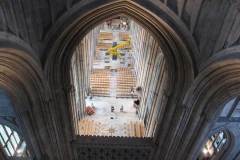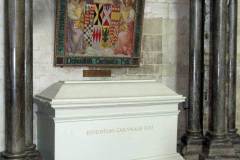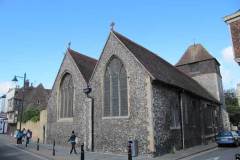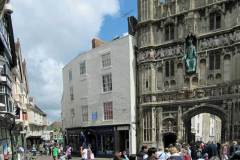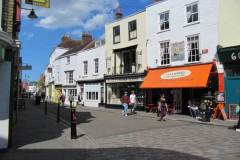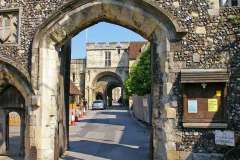Elizabethan Poet, Writer and Playwright
When the floor of Canterbury cathedral nave (image 1) was re-paved in 1787, amongst the human remains removed and reburied in the cloister were those of Peter Lyly (sometimes Lily), a former Registrar of Canterbury Consistory (ecclesiastical) Court who had died in 1569. Peter’s father, William, had written the standard guide to Latin grammar used by generations of Elizabethan pupils. His brother, George Lyly, had been a long standing friend and secretary to Cardinal Pole (image 2), so when Pole became Archbishop of Canterbury George moved to Canterbury to become a canon at the cathedral. By the 1560s we know that Peter was living in Canterbury with his Yorkshire-born wife Jane, as baptism entries for six of their eight children (not John) appear in the registers of St Alphege church (image 3). John, their first child, born around 1554, became a successful writer and playwright, a primary influence on Shakespeare’s writing style, and the promoter of a new prose style known as ‘euphuism’. This flourished in the 1580s and took its name from Lyly’s romance ‘Euphues or the Anatomy of Wit’. It is marked by ‘an elaborately ornate style richly decorated with rhetorical figures … repeated use of antitheses, reinforced by alliteration, along with rhetorical questions’ (Oxford Dictionary of Literary Terms). The same Ephues source is quoted as the origin (in a slightly different form) for the modern proverb ‘All’s fair in love and war’.
John left to study at Oxford around 1570 and obtained his MA in 1575. Alongside success as a writer, he sat as MP for Hindon in 1580, Aylesbury in 1593, Appleby in 1597, and Aylesbury again in 1601. He married and apparently had three children but died in London in 1606, poor and neglected. His Canterbury connections are as follows:
- The strong cathedral links of his uncle George Lyly and father Peter Lyly.
- The certainty that John spent his childhood in the city – records suggest that the Lyly home must have been in Sun Street or Palace Street (images 4 and 5). We know that this home was known as the ‘Splayed eagle’ and a detailed inventory of its contents at the time of Peter’s death in 1569 survives in the probate records in the Cathedral Archives.
- The likelihood that, like his brothers and sisters christened at St Alphege’s church, John was born in Canterbury, although the Dictionary of National Biography mentions Rochester as an alternative as Peter Lyly acted as a lawyer there in 1550
- The likelihood that John attended King’s School (image 6) – his brothers William and Peter certainly did, and the King’s web site claims him amongst their alumni
Whether or not John’s birth or schooling in the city can ever be proven, the strong links to Canterbury of several leading Elizabethan literary figures (Marlowe, Lyly and also the drama critic and actor Stephen Gosson) is remarkable.
Sources: Advice from Dr Andy Kesson (University of Kent); Bateman (1984); Urry (1960); Oxford Dictionary of National Biography
DL

